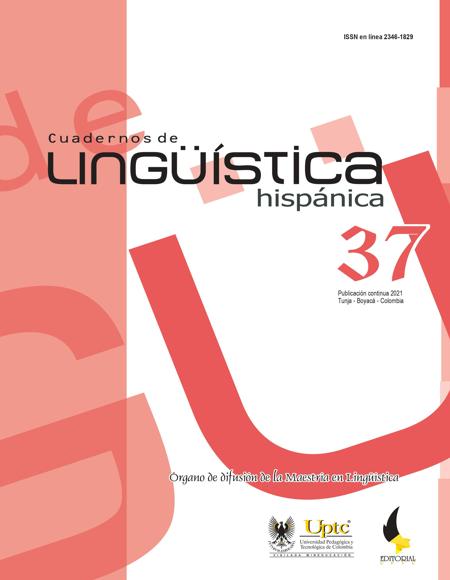Variación sociofonética: comparación de análisis graduales y categóricos

Resumo
En este artículo se comparan los resultados de dos modelos de análisis sociofonético diferentes: un modelo continuo y uno categórico. La variable sociofonética investigada es la producción de /d/ intervocálica en Madrid. En el modelo continuo, el debilitamiento de /d/ fue calculado tomando medidas acústicas de intensidad, de tal forma que dicho análisis puede dar cuenta de manera precisa de todo el espectro de posibles realizaciones de /d/ (i.e., desde muy oclusivas hasta muy debilitadas). En el modelo categórico, el debilitamiento de /d/ fue codificado de manera binaria (retención o elisión total) de modo que este análisis da cuenta únicamente del caso más extremo de debilitamiento consonántico: la elisión. En ambos análisis estadísticos se incluyeron las mismas variables independientes lingüísticas y extralingüísticas. Aunque los resultados de ambos análisis muestran semejanzas significativas en cuanto al efecto de las variables independientes, también se encontraron diferencias. Además de proveer una caracterización sociofonética de la producción de /d/ en Madrid, en este artículo se resaltan algunos de los beneficios de usar técnicas y métodos graduales en la investigación sociofonética.
Palavras-chave
Acústica, Fonética, Metodología, Sociolingüística
Referências
Bates D., Mächler M., Bolker B., & Walker S. (2015). Fitting Linear Mixed-Effects Models Using lme4. Journal of Statistical Software, 67(1), 1–48. https://doi. org/10.18637/jss.v067.i01.
Blanco, A. (2004). Estudio sociolingüístico de Alcalá de Henares. Servicio de Publicaciones de la Universidad de Alcalá.
Bybee, J. (2002). Word Frequency and Context of Use in the Lexical Diffusion of Phonetically Conditioned Sound Change. Language Variation and Change 14(3), 261–290. https://doi.org/10.1017/S0954394502143018.
Bybee, J. (2006). From Usage to Grammar: The Mind’s Response to Repetition.
Language, 82(4), 711–733. https://doi.org/10.1353/lan.2006.0186.
Carrasco, P., Hualde, J. I., & Simonet, M. (2012). Dialectal Differences in Spanish Voiced Obstruent Allophony: Costa Rican versus Iberian Spanish. Phonetica 69(3), 149–179. https://doi.org/10.1353/lan.2006.018610.1159/000345199.
Díaz-Campos, M. (2016). Nuevas tendencias en el análisis de la variación sociofonológica: una comparación de análisis tradicionales basados en la categorización en contraste con estudios fundamentados en medidas
acústicas. En Ponencia presentada en el 8th International Workshop on Spanish Sociolinguistics. Universidad de Puerto Rico.
Díaz-Campos, M., Scrivner, O., & Delgado-Díaz, G. (2015). A Real Time Comparison of the Lenition of Intervocalic /d/ in Spanish: Examining the Changes in the Sociolinguisic Profile from 1997 to 2004-2010. En Póster presentado en NWAV44 (New Ways of Analyzing Variation 44). Universidad de Toronto.18 Variación sociofonética: comparación de análisis graduales y categóricos
File-Muriel, R. J., & Brown, E. K. (2011). The Gradient Nature of S-Lenition in Caleño Spanish. Language Variation and Change, 23(02), 223–243. https://doi. org/10.1017/S0954394511000056.
Fox, J., & Weisberg, S. (2019). An R Companion to Applied Regression (3rd ed.). Sage.
Gil, N. (2004). Estudio sociolingüístico de la fonética de la ciudad de Madrid. (Memoria de licenciatura inédita). Universidad de Alcalá.
Gómez, A. (1994). Aspectos del habla de Linares (Jaén). (Tesis doctoral). Universidad
de Málaga.
Gómez, J. R., & Gómez, M. (2010). Mantenimiento y elisión de la /d/ intervocálica en
el español de Valencia. Verba, 37, 89–122.
Hualde, J. I., (2014). Los sonidos del español. Cambridge University Press.
Hualde, J. I., Simonet, M., & Nadeu, M. (2011). Consonant Lenition and Phonological Recategorization. Laboratory Phonology, 2(2), 301–329. https://doi. org/10.1515/labphon.2011.011.
James, G., Witten, D., Hastie, T., & Tibshirani, R. (2013). An Introduction to Statistical Learning: With Applications in R. Springer.
Jiménez, R. (2020). Variación fonológica de la /d/ intervocálica en el sociolecto alto de Sevilla. Rilce, 36(2), 674–707. https://doi.org/10.15581/008.36.2.674-707.
Kuznetsova, A., Brockhoff, P., & Christensen, R. (2017). lmerTest Package: Tests in Linear Mixed Effects Models. Journal of Statistical Software, 82(13), 1–26.https://doi.org/10.18637/jss.v082.i13.
Lozano, M. C. (1979). Stop and Spirant Alternations: Fortition and Spirantization Processes in Spanish Phonology. (Tesis doctoral). Indiana University.
Malaver, I. & Perdomo, L. (2016). La elisión de /d/ en posición intervocálica en la comunidad caraqueña. Boletín de Filología, 51(2), 147–179. Mascaró, J. (1991). Iberian Spirantization and Continuant Spreading. Catalan
Working Papers in Linguistics, 1, 167–179.
Moya, J. A. (1979). La pronunciación del español en Jaén. (Tesis doctoral). Universidad de Granada.
Moya, J. A. (2009). Las tensiones del cambio lingüístico a propósito de la elisión de la /d/ intervocálica. En E. Montoro del Arco (ed.), El español del siglo XXI. 19
Fernando Melero García Cuadernos de Lingüística Hispánica n.° 37, 2021. +https://doi.org/10.19053/0121053X.n37.2021.12184
Actas de las XIV Jornadas sobre la lengua española y su enseñanza (pp. 211–220). Universidad de Granada.
Ortega-Llevaria, M. (2003). Effects of Phonetic and Inventory Constraints in the Spirantization of Intervocalic Voiced Stops: Comparing Two Different Measurements of Energy Change. In M. J. Solé, D. Recasens & J. Romero
(eds.), Proceedings of the XV International Congress of Phonetic Sciences (pp. 2817–2820).
Pérez , A. M. (2003). Estudio sociolingüístico de El Hierro. (Tesis doctoral). Universidad de Las Palmas de Gran Canaria. PRESEEA (2014). Corpus del Proyecto para el estudio sociolingüístico del español
de España y de América. Universidad de Alcalá. http://preseea.linguas.net.
R Core Team (2020). R: A Language and Environment for Statistical Computing. R Foundation for Statistical Computing, Vienna, Austria. https://www.R-project. org/.
Rogers, B. (2016). The Influence of Linguistic and Social Variables in the Spirantization of Intervocalic /b, d, g/ in Concepción, Chile. Studies in Hispanic and Lusophone linguistics, 9(1), 207–237. https://doi.org/10.1515/shll-2016-0008.
Samper, J. A. (2011). Sociophonological Variation and Change in Spain. In M. DíazCampos (ed.), The Handbook of Hispanic Sociolinguistics (pp. 98–120).Wiley-Blackwell